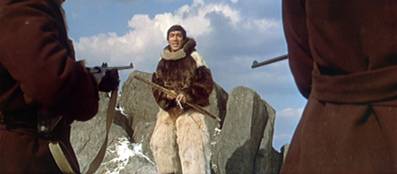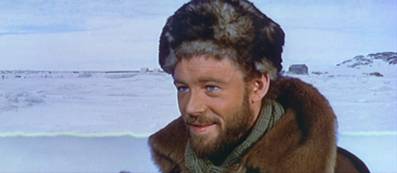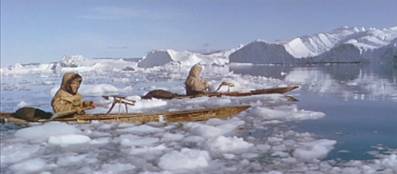|
For
a more sensitive modern audience, Nicholas Ray's 1959 The
Savage Innocents may present a few problems. For
a start, an animal gets killed in the opening scene, and in these pre-CGI
days it gets killed for real. This sequence, which was cut
from the original theatrical release, sees a polar bear
swimming in the arctic waters shortly before it is hit twice
by spears and begins bleeding into the sea, the innocence
and savagery of the title, the commentary track suggests.
In a documentary on the Inuit people we may well expect
this, but in a fictional feature it is likely to catch the
unwary by nasty surprise.
And then there's the cast. Despite the story being about
the Inuit, or the Eskimo people as they were then called,
there are precious few if any Eskimos in it. The lead actor
was born in Mexico and his character's family and friends are played
by a mixture of Japanese and Chinese actors. They are about
as believable as Eskimos as Marlon Brandon was as a Japanese
in Teahouse of the August Moon.
The Eskimo life is as romanticised as it was by Robert Flaherty
in his 1922 Nanook
of the North, and is observed from a (then)
modern American perspective. Even the
title betrays this viewpoint, suggesting the Eskimo people
as savage innocents: innocent because they do not understand
the ways of so-called 'civilised' society, savage because
they do not adhere to its moralistic and behavioural restrictions.

So
one for the Cupboard of Shame, then? Absolutely no bloody
way. When I said they were barriers I meant it, but these
are barriers that should be soundly kicked aside in order
to get to what is, especially for its time and country of
origin, a genuinely remarkable work. Think
about it for a minute. The film was distributed by a Hollywood
studio (Paramount) back in 1959, a time when there were
almost no non-Caucasian lead actors working in mainstream
American cinema and white actors were regularly cast in ethnic roles.
This film's star, Anthony Quinn, portrayed characters
of a wide range of nationalities during his career: he played an Italian
in Fellini's La Strada in 1954, French
painter Paul Gauguin in Vincente Minnelli's Lust
for Life in 1956 (which also featured Kirk Douglas
as Dutch painter Vincent van Gogh), Arab tribal leader Auda
abu Tayi in David Lean's Lawrence of Arabia
in 1962, and he was nominated for an Oscar for the title role
in Michael Cacoyannis's Zorba the Greek
in 1964. And let's not forget that Atanarjuat, The Fast
Runner, the first feature film
that told an authentic Inuit story that was made by an Inuit director with a genuinely Inuit cast, did not appear until 2001. At
a time when Native Americans were still being portrayed
(sometimes by white actors in redskin make-up) as the bad
guys in westerns, The Savage Innocents
shows the Eskimos and their lifestyle in a surprisingly
positive light. It includes elements that would be regarded
by so-called 'civilised' society of the time as primitive
and even morally unsound, and presents them in as everyday
events and actions, which to the characters in this setting they
were, of course.
Consider
the first post-title scene. Jovial Eskimo bachelor Inuk arrives at
the igloo of his good friend Anarwik and his wife Lulik
and finds them in bed, and they are not sleeping, if you get my drift.
There is no embarrassment on anybody's part – indeed, Inuk
grabs some food and all three exchange cheerful conversation
as if they've just met up in a bar. A short while later,
Inuk is expressing his desire to take a wife of his own,
not easy in a climate where the men greatly outnumber the
women, and Anarwik, as his friend, offers his own wife for
Inuk to 'laugh' with (oh come on, you can work it out),
something that is clearly common practice here. This one
time Inuk turns Anarwik down – he wants his own woman –
and Anarwik takes considerable offence. A scuffle ensues
and Inuk settles the argument by banging Anarwik's head
against the igloo wall hard enough to knock him silly. This is 1959 and here is a film in which the concept
of the sharing of wives with friends and visitors for sex
is presented as perfectly natural behaviour. And that it is,
at least in the context of the society in which we have
very quickly been immersed. Later examples of cultural behavioural
differences include Inuk reviving a man's frozen hands by
killing a dog, cutting open its belly and thrusting the
affected limbs into the innards (it's OK, it happens just
off screen), Inuk's wife-to-be warming his feet by placing
them under her clothing against her chest – something that a few
seconds later is on full display – and a grandmother who
is no longer able to shape leather with her worn-out teeth
being left on the ice to be eaten by a polar bear (so that
it might eat, live, and be later killed by Inuk and feed his
own children).

Crucial
to this non-judgemental presentation is the absence of the
innocent newcomer, a familiar film character used to extract plot and character
information and react to events on the audience's behalf. With no outsider
passing judgement on the society and its people, we are more
readily able to feel part of this community and accept its behavioural codes as the norm. How accurate they are is another
matter entirely, but some cursory research suggests that much of
it is on the nose, and no less authentic than Flaherty's
portrait of Nanook and his family (tellingly, there is a
seal-catching scene early on that seems to directly pay
tribute to Flaherty). And having
engaged us with the characters and their customs and convinced
us us to accept the concept of open marriages, the film
then has a laugh at the idea of God and religion and
suggests that the whole concept of free trade, the bedrock
of western capitalism, is somehow corrupting and destructive.
But
I'm getting ahead of myself – let's talk a little plot,
or should I say plots, as there are actually three. The
first introduces us to Inuk and his lifestyle and revolves
around his search for a wife. And wouldn't you know it,
no women come along for ages and then two turn up at once,
both daughters of Anarwik's brother. Inuk can't choose between
them, but ends up with Asiak (and her mother) by default
after her sister Imina is snagged by a less hesitant bachelor.
Plot
two kicks off with Inuk patiently hunting a polar bear (you
have to concentrate or switch on the commentary to realise
just how he is wearing the animal down), only to be shaken
when an explosive sound results in the bear's sudden death.
This is Inuk's first experience of the deadly power of a
rifle, wielded by a fellow hunter who tells Inuk that he
too can own a weapon of such power by trading fox pelts.
Inuk thus abandons the traditional practice of hunting only
what you need for food and spends the following months chasing
exclusively after foxes, then hauls them to a distant trading
post to gain his firearm. The trading post represents a
somewhat jarring disruption of Inuk's until then happily
simple life (visually echoed in the mise-en-scene, as pure
white snowscapes give way to the darker, cluttered interior
of the trading post), modernity versus traditional values,
vividly represented by the rock 'n' roll song that
blasts out of the record player, making Inuk jump and rudely
reminding us of everything disruptive and destructive about
the intrusion of western society on cultures the world over.

This is also the clearest indication of the film's
idealisation of Eskimo culture. Until this point there is
little indication of the period in which the film is set, save for the opening voiceover that talks of the Eskimos
using bows and arrows in 'the atomic age', but the record
played at the trading post puts us firmly in the 1950s.
One of the criticisms aimed at Nanook
of the North was that Flaherty had his subjects
hunting with spears, paddling their kayaks, and living in
igloos when by then they were already using rifles to hunt,
outboard motors to power their boats, and living in wooden
buildings in the western style, and that was back in 1922.
Inuk would have to be living in a pretty remote spot to
have missed out on thirty years of subsequent change. Like Nanook,
he is presented by the filmmakers as symbolic of a vanishing
way of life, a view encapsulated by the trader's comment on the arrival
of Inuk and his family at the trading post, "Ten years
ago, nearly all the Eskimos were like those three. Magnificent."
Plot
three, which provides the films dramatic core, begins with
the visit of a friendly missionary to Inuk's igloo, his
intention being to bring Christianity to the lives of these
happily godless people. Inuk fails to understand the man's message
or intentions – on being told that the Lord will be
with him on his travels, he wonders if this Lord is a good
hunter, while Asiak remarks that he will have to bring his
own sledge. As a traditional act of friendliness, Inuk first offers
the man his oldest meat and then the opportunity to 'laugh'
with his wife – the missionary reacts with horror, offending
Inuk, who once again bangs the man's head against the igloo
wall. But missionary heads are clearly more fragile than
Eskimo ones and the man is killed. Enter, some time later,
the two Mounties charged with arresting Inuk and taking
him back to trial and probably execution, and the clash
of cultures reaches a dangerous crossroads.
As
I said up front, there are a few barriers to clamber over, but if you can contextualise
the film into it's place and time, deal with the non-Eskimo
cast and the occasional romanticising of the Eskimo lifestyle,
and shield your eyes if you have to for the opening scene,
then The Savage Innocents is a seriously
impressive achievement. It's true outsider cinema, a work that celebrates
without overly idealising the values and lifestyle of a
people whose ways are very different to those of its intended
audience. Anthony Quinn may be a good foot taller than even
the lankiest Eskimo, but in every other way his performance
is just right, from his facial reactions and body language
to his vocal delivery – this is Quinn at pretty much the
top of his game. The supporting cast do well, but in amongst
them lies a performance that may have been of considerable
note were it not for post-production interference. One
of the Mounties is played by a
young Peter O'Toole in his first film role, but although facially and physically
he is already displaying the star quality that three years
later would explode in Lawrence of Arabia,
his voice has been dubbed with what the commentary nicely
describes as Spaghetti Western American, making it impossible
to judge his delivery in what proves to be a crucial role
for the narrative.

Visually
the film is often breathtaking, and while the mix of location,
studio work and process shots is sometimes a tad distracting,
much of the footage shot on location in the Arctic is genuinely
beautiful and the arrangement of characters and objects
within the scope frame consistently impressive. It even
manages a moment of surrealism amidst the harshness of wilderness
survival, as a man, retrieved from the icy arctic waters
despite Inuk's dismissal of his survival chances, stands
rigid and freezes to death before our eyes.
The
Savage Innocents may not go down in history as
a bona fide classic, but it's still an extraordinary example
of outsider cinema produced within the studio system. With
its warmly uncritical portrayal of a culture and lifestyle
whose rules are sometimes contrary to our own, it cannot help
but come across as progressive and forward-looking on a
variety of issues, and can be seen as a key work both for
director Ray and star Quinn. And yes, the rumours are apparently
true that Bob Dylan's The Mighty Quinn was inspired
by this film. As the song says, "You'll not see nothing
like the Mighty Quinn..."
Despite
some minor flickering in the early stages and a tiny bit
of damage here and there, this is a largely excellent transfer
that belies the film's age and wonderfully showcases Aldo
Tonti's scope cinematography. Colour, contrast and detail
all appear to be on the nose, and the white snowscapes,
a notorious nightmare for any digital medium, look terrific.
The framing is 2.35:1 and the picture in anamorphically
enhanced.
The Dolby 2.0 mono soundtrack has a slight hiss, a few minor
pops and the occasional crackle, but is otherwise very pleasing
and clear.
The
main extra here is a Commentary
by critic and journalist David Ehrenstein and the US correspondent
for Cahiers du cinema, Bill Krohn. It gets off to
a slightly goofy start as Ehrenstein, observing the wide
shot that follows the titles, says "Here we are in
the arctic wastes of...the arctic wastes," but this
is a rare example of the two fumbling for words. On the
whole they provide a very enjoyable and informative analysis
of the film, its relationship to the novel on which it was
based (Hans Ruesch's Top of the World), the footage
that was cut for its original British and American releases,
as well as the various influences of and relationships
to other works, from Brecht and Edward Hopper to the anthropological
documentaries of Jean Rouch. In an interesting and effective
move that I last encountered on the Lantana
DVD, the two are given a separate front speaker each, making
it easy to know who is saying what, even if this initially
gives you a bit of a start. Oh yes, and stay with the end credits
if you want to hear the pair singing The Mighty Quinn.
The
Gallery consists of 17 front-of-house
cards and posters for the film, most in good shape and all
reproduced at a decent size.
The
usual Masters of Cinema Booklet
was not supplied with the review disc, but we can expect
this to be up the usual high standards and should feature
reproductions of the original promotional material for the
film.
Despite
my enthusiasm for the film, I'm not going to pretend that
The Savage Innocents is a masterpiece,
but it fully deserves to find favour in the realms of cult
cinema, where it should sit very neatly. Checking reaction
on the IMDB and beyond I was surprised and encouraged by
the strength of passion I saw for the film, with negative
reaction confined largely to the on-screen animal killing
(understandable, but it's over quickly) and its seeming
rejection of western Christian values, which alone will
win it a place in many hearts.
Masters
of Cinema have scored again by restoring the film to its
original cut and presenting it so handsomely. For fans of
outsider cinema, this comes highly recommended. Self-appointed
moral guardians, on the other hand, should steer clear
and go find someone to laugh with.
|